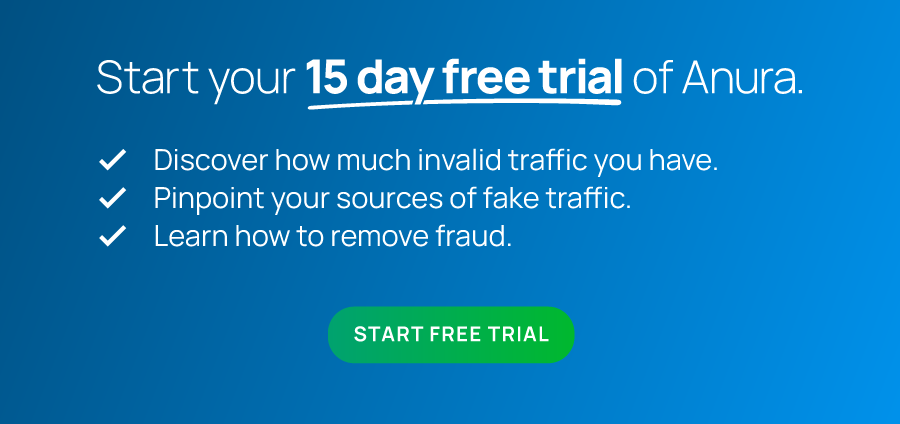Top Signs an Influencer Is Using Bot Traffic

TL;DR
- Learn how to tell if someone bought followers before investing in influencers.
- Fake followers and traffic bots distort engagement and waste ad spend.
- Authentic growth patterns show steady engagement; fakes spike unnaturally.
- Watch for mismatched demographics, generic comments, and odd growth.
- Always verify audience authenticity with analytics and fraud detection tools like Anura’s Social Search and Protect.
Internet influencers are online “celebrities” who have massive followings and can help start trends to build awareness by endorsing a product. Alternatively, they can drive their audience away from products by insulting them on social media, as well. For businesses, partnering with influencers can be a powerful way to reach a new audience and drive conversions.
But if you’ve ever wondered how to tell if someone bought followers, you’re not alone. Not all influencers are equal. In fact, some influencers may not be as influential as they claim to be. Many influencers artificially boost their follower counts using fake accounts or traffic bots, making them appear more popular than they really are.
This follower fraud can inflate engagement metrics and deceive brands into investing ad spend on fake audiences. Knowing how to tell if someone bought followers on Instagram or how to tell if someone bought TikTok followers helps marketers protect their budgets and partner only with authentic creators.
How Traffic Can Play a Role in Influencer Marketing
In recent years, influencer marketing has been compared to celebrity endorsements. According to Influencer Marketing Hub, the practice of influencer marketing “takes the idea of celebrity endorsement and places it into a modern-day content-driven marketing campaign.” They also noted that “businesses are making $6.50 ROI for every $1 spent on influencer marketing,” which highlights the value of this marketing channel.
It’s natural to check follower count, pageviews, or engagement rates as signals of value. But these metrics are vulnerable to manipulation. Traffic, especially if it comes from bot-driven engagement, becomes suspicious when used to artificially inflate influence. On platforms like Instagram, TikTok, and Twitter, bots and purchased followers can distort those metrics dramatically.
It’s believed that the more traffic an influencer has on social media, the more valuable they typically are as an advertising partner. But even if an influencer claims millions of followers, unless those followers are active and real, they won’t convert. So, knowing how to tell if someone bought their followers helps protect your brand from masked fraud.
For example, say that Influencer A has a YouTube channel with one million subscribers, while Influencer B has a channel with 100,000 subscribers. Assuming both have equal influence on their subscribers’ purchasing decisions and are in an equally relevant niche, Influencer A would be 10 times more valuable as a marketing partner compared to Influencer B.
While traffic is far from being the only metric that demonstrates an influencer’s worth to an organization's online advertising campaigns, it is an important one, and one of the first metrics that most marketers will look at.
What Other Factors Should You Consider When Checking Out Influencers?
Follower count can tell one part of the puzzle, but it doesn’t show you the whole picture. To truly understand an influencer’s credibility, you need to look beyond vanity metrics and focus on engagement quality and audience authenticity.
When evaluating a potential influencer partner, consider these:
- Engagement ratio vs follower size. If someone has 100,000 followers but consistently gets only a few dozen likes or comments, that disproportion hints at fake or inactive audiences.
- Growth trends over time. Real follower growth happens gradually. Sudden jumps may suggest purchase or bot-generated growth. Tools like Social Blade or HypeAuditor help show that.
- Quality of comments. Genuine followers comment with substance; bot-driven accounts often leave vague, repetitive comments like “Nice post!” or “Love this!”
- Cross-platform consistency. Compare their Instagram, TikTok, and Twitter (X) accounts. If someone is huge on one platform but nearly nonexistent on others, that discrepancy may expose fake follower behavior.
- Quality of traffic. Use a fraud detection tools like Anura to flag invalid traffic.
Ultimately, knowing how to tell if someone bought followers requires combining manual review with technology that can detect hidden fraud.
3 Ways Fraudulent Influencers Use Bot Traffic to Skew Data
About 50% of influencers on Instagram have been found to be engaging in some form of fraud or fakery on the platform (Source: Market Haven). Influencer marketing fraud, or the practice of an influencer using bots and other fraud techniques to artificially inflate their engagement with advertisers, can cost millions of dollars. Buteven after superficial checks, bots often hide under the hood.
Here are three tactics fraudulent influencers use to manipulate metrics:
-
Artificial View Inflation
One of the simplest tricks an influencer can perform with bot traffic is using it to make it look like their social media posts are being seen by more people than they are. Bots can endlessly refresh posts or videos to inflate view counts. This creates an illusion of reach that never translates to real interest or conversions.
-
Fake Engagement with Likes and Comments
Digiday noted that “engagement has been prioritized as a top metric of success for influencer marketing.” This metric, when combined with traffic, helps to demonstrate the value of an influencer as a marketing partner. However, some fraudulent influencers use bots to leave automated comments on their videos to make it look like they have high engagement rates.
-
Generating Fake Leads and Conversions
Instead of trying to inflate their value so marketing partners will pay more for ad time or mentions in their content, some influencer fraudsters will leverage bots to generate fake leads after entering a “partnership” with an advertiser. These lead gen fraudsters use bots to fill out forms on the advertiser’s website—tricking them into believing that the fraudster is generating value for their marketing spend. These tricks inflate reach and engagement metrics, twisting marketing decisions based on illusions rather than real performance.
Warning Signs an Influencer Is Using Bot Traffic
Considering how easily influencers can use bot traffic to inflate their numbers and defraud companies of their marketing budgets, it’s important to know how to identify such fraudsters.
Here’s how you can spot if an influencer is relying on bots or fake followers:
-
1. A High Follower Count with Very Little Content History
If an account is very new but already shows millions of followers or views, that’s suspicious. Authentic accounts usually grow content and audience together over time.
-
2. Abnormal Engagement Rates on Posts
When videos with thousands of views only get ten likes, or massive likes with zero authentic comments, that signifies that followers were purchased or there’s bot-driven activity occurring.
-
3. Low Quality Engagement and/or Repeated Comments
Bots often generate generic comments. If many comments across multiple posts are almost identical, you’re most likely seeing automated responses instead of real conversations.
-
4. Sudden Spikes in Followers
If someone jumps from tens of thousands to millions of followers overnight with no explanatory content, suspect they bought followers.
-
5. Audience is Made Up of Blank or Low-Quality Accounts
Sometimes, the best way to determine if an influencer is real is to look at their audience. A lot of bots use very basic fake accounts to “engage” with the fake influencer’s content.
These accounts may have:
- Copy/pasted the same data to different accounts. If half of an influencer’s followers have the same birthday, street address, or favorite food, those accounts are fake.
- Only shown engagement with the influencer’s content. Most people will at least view other influencers’ content while scrolling through Facebook, YouTube, or Instagram.
- Been created at the same time. If 90% of an influencer’s followers all created their accounts within 24 hours of one another, and they all only follow that one influencer, odds are good that they’re fake followers.
- Have only minimal information in them. While some people do only fill out the bare minimum necessary information to create their social media profiles, it can be a warning sign of influencer fraud if all an influencer’s followers have only barebones account information.
How an Ad Fraud Solution Can Stop Traffic Bots and Influencer Fraud
Understanding how to tell if someone bought followers helps you prevent wasted marketing spend. But execution is key:
- Always vet influencer analytics before committing.
- Use detection tools to monitor campaign traffic.
- Partner with creators whose audience grows naturally and engages authentically.
- Structure performance-based contracts tied to real outcomes: clicks and conversions, not just follower count.
When you combine manual inspection with fraud detection, you protect your campaigns and your budget.
The world of influencer marketing is built on trust. But fake followers and traffic bots are eroding that foundation. Learning how to tell if someone bought followers gives you powe tor: invest smarter, protect your data, and build genuine partnerships that convert.
Being vigilant against traffic bots and influencer fraud is a good starting point. However, manually checking for fraud can be a massive time sink. Also, it’s easy to look at one metric and assume that something is fraud when it really isn’t, leading to false positives that cause companies to throw good leads away with the bad.
To help maximize fraud detection while minimizing costly mistakes, it’s important to leverage a powerful and accurate ad fraud solution. How do ad fraud solutions help stop traffic bots and influencer fraud?
One way Anura stops fraud is by analyzing website traffic in real time as it comes through your website. This helps to detect form-filling bots that fake influencers might send your way. Also, by analyzing hundreds of data points at once and recording the reasons why traffic is flagged as fraudulent, Anura makes it easy to fake leads back to fraudsters and confront them.
Are you ready to transform your influencer marketing campaigns by weeding out the fraudsters and tightening relationships with the ones that are providing real value? Reach out to the ad fraud experts at Anura to get started!


